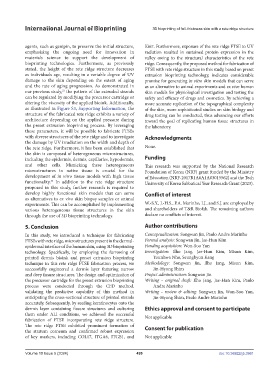Page 507 - IJB-10-5
P. 507
International Journal of Bioprinting 3D bioprinting of full-thickness skin with a rete ridge structure
agents, such as genipin, to preserve the initial structure, Ki67. Furthermore, exposure of the rete ridge FTSE to UV
emphasizing the ongoing need for innovation in radiation resulted in sustained protein expression in the
materials science to support the development of valley owing to the structural characteristics of the rete
bioprinting technologies. Furthermore, as previously ridge. Consequently, the proposed method for fabrication of
stated, the height of the rete ridge structure decreases FTSE with rete ridge structure in this study, based on preset
as individuals age, resulting in a variable degree of UV extrusion bioprinting technology, indicates considerable
damage to the skin depending on the extent of aging promise for generating in vitro skin models that can serve
and the rate of aging progression. As demonstrated in as an alternative to animal experiments and ex vivo human
our previous study, the pattern of the extruded strands skin models for physiological investigation and testing the
23
can be regulated by modifying the precursor cartridge or safety and efficacy of drugs and cosmetics. By achieving a
altering the viscosity of the applied bioink. Additionally, more accurate replication of the topographical complexity
as illustrated in Figure S3, Supporting Information, the of the skin, more sophisticated studies on skin biology and
structure of the fabricated rete ridge exhibits a variety of drug testing can be conducted, thus advancing our efforts
architecture depending on the applied pressure during toward the goal of replicating human tissue structures in
the preset extrusion bioprinting process. By leveraging the laboratory.
these parameters, it will be possible to fabricate FTSEs
with diverse structures of the rete ridge and to investigate Acknowledgments
the damage by UV irradiation on the width and depth of
the rete ridge. Furthermore, it has been established that None.
the skin is composed of heterogeneous microstructures,
including the epidermis, dermis, capillaries, hypodermis, Funding
and other cells. Mimicking these heterogeneous This research was supported by the National Research
microstructures in native tissue is crucial for the Foundation of Korea (NRF) grant funded by the Ministry
development of in vitro tissue models with high tissue of Education (NRF-2017R1A6A1A03015562) and the Tech
functionality. In addition to the rete ridge structure University of Korea Sabbatical Year Research Grant (2023).
42
proposed in this study, further research is required to
develop highly functional skin models that can serve Conflict of interest
as alternatives to ex vivo skin biopsy samples or animal
experiments. This can be accomplished by implementing W.-S.Y., J.-H.S., P.A. Marinho, I.J., and S.J. are employed by
various heterogeneous tissue structures in the skin and shareholders of T&R Biofab. The remaining authors
through the use of 3D bioprinting technology. declare no conflicts of interest.
5. Conclusion Author contributions
In this study, we introduced a technique for fabricating Conceptualization: Songwan Jin, Paulo Andre Marinho
FTSEs with rete ridge, microstructures present in the dermal- Formal analysis: Songwan Jin, Jae-Hun Kim
epidermal interface of the human skin, using 3D bioprinting Funding acquisition: Won-Soo Yun
technology. Specifically, by employing the furrowing of Investigation: Ilho Jang, Jae-Hun Kim, Misun Kim,
printed dermis bioink and preset extrusion bioprinting Younhwa Nho, Seunghyun Kang
technique in this rete ridge FTSE fabrication process, we Methodology: Songwan Jin, Ilho Jang, Misun Kim,
successfully engineered a dermis layer featuring narrow Jin-Hyung Shim
and deep fissure structures. The design and optimization of Project administration: Songwan Jin
the precursor cartridge for the preset extrusion bioprinting Writing – original draft: Ilho Jang, Jae-Hun Kim, Paulo
process were conducted through the CFD method, Andre Marinho
validating the predictive capability of this method in Writing – review & editing: Songwan Jin, Won-Soo Yun,
anticipating the cross-sectional structure of printed strands Jin-Hyung Shim, Paulo Andre Marinho
accurately. Subsequently, by seeding keratinocytes onto the
dermis layer containing fissure structures and culturing Ethics approval and consent to participate
them under ALI conditions, we achieved the successful Not applicable
fabrication of FTSE incorporating rete ridge structure.
The rete ridge FTSE exhibited prominent formation of Consent for publication
the stratum corneum and confirmed robust expression
of key markers, including COL17, ITGA6, ITGB1, and Not applicable
Volume 10 Issue 5 (2024) 499 doi: 10.36922/ijb.3961

